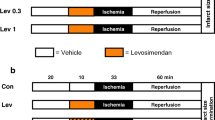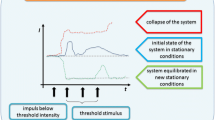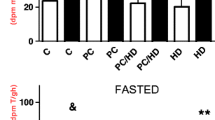Conclusion
These observations support the view that the mechanism responsible for the anti-infarct effect of ischemic preconditioning is far from being completely understood. The potential involvement of reduced Na+/H+ exchange in this effect cannot be ruled out on the basis of currently available, information and illustrates the uncompletness of our knowledge of the molecular mechanisms responsible for the cardioprotective effect of preconditioning. The potential role of attenuated Na+/H+ exchange in this effect cannot be easily integrated into the signal cascade of messengers proposed for preconditioning, but may be seen as a mechanism acting in parallel. The importance of this mechanism may depend on the conditions, as initial glycogen content or alternative routes of Na+ gain. These conditions may be different in the isolated crystalline perfused heart as compared toin situ myocardium. Further studies are necessary to resolve the possible role of attenuated acidosis and Na+/H+ exchange in ischemic preconditioning. These studies should aim to dissociate glycogen depletion, attenuated acidosis, and reduced Na+/H+ exchangein situ preconditioned myocardium.
Similar content being viewed by others
References
Allshire A, Piper HM, Cuthbertson KSR, Cobbold PH (1987) Cytosolic free Ca2+ in single rat heart cells during anoxia and reoxygenation. Biochem J 244:381–85
Arad M, De Jong JW, De Jonge R, Huizer T, Rabinowitz B (1996) Preconditioning in globally ischemic isolated rat hearts: effect on function and metabolic indices of myocardial damage. J Mol Cell Cardiol 28 (12):2479–90
Asimakis GK (1996) Myocardial glycogen depletion cannot explain the cardioprotective effects of ischemic proconditioning in the rat heart. J Mol Cell Cardiol 28 (3):563–70
Bugge E, Ytrehus K (1995) Inhibition of sodium-hydrogen exchange reduces infarct size in the isolated rat heart — a protective additive to ischaemic preconditioning. Cardiovasc Res 29 (2):269–74
Cross HR, Opie LH, Radda GK, Clarke K (1996) Is a high glycogen content beneficial or detrimental to the ischemic rat heart? A controversy resolved. Circ Res 78 (3):482–91
Dekker LR, Fiolet JW, VanBavel E, Coronel R, Opthof T, Spaan JA, Janse MJ (1996) Intracellular Ca2+, intercellular electrical coupling, and mechanical activity in ischemic rabbit papillary muscle. Effects of preconditioning and metabolic blockade. Circ Res 79 (2):237–46
Garcia-Dorado D, González MA, Barrabés JA, Ruiz-Meana M, Solares, J, Lidon RM, Blanco J, Puigfel Y, Piper HM, Soler-Soler J (1997) Prevention of ischemic rigor contracture during coronary occlusion by inhibition of Na+−H+ exchange. Cardiovasc Res (in press)
Inserte J, Garcia-Dorado D, Ruiz-Meana M, Solares J, Soler-Soler J (1997) The role of Na+−H+ exchange occurring during hypoxia in the genesis of reoxygenation-induced myocardial oedema. J Mol Cell Cardiol 29:1167–75
King LM, Opie LH (1996) Does preconditioning act by glycogen depletion in the isolated rat heart? Mol Cell Cardiol 28 (12):2305–21
Kolocassides KG, Galinanes M, Hearse DJ (1996) Dichotomy of ischemic preconditioning: improved postischemic contractile function despite intensification of ischemic contracture. Circulation 93 (9):1725–33
Murphy E, Perlman M, London RE, Steenbergen C (1991) Amiloride delays the ischemia-induced rise in cytosolic free calcium. Circ Res 68:1250–58
Ramasamy R, Liu H, Anderson S, Lundmark J, Schaefer S (1995) Ischemic preconditioning stimulates sodium and proton transport in isolated rat hearts. J Clin Invest 96 (3):1464–72
Ruiz-Meana M, Garcia-Dorado D, Juliá M, Inserte J, Gonzáles MA, Barrabés JA, Soler-Soler J (1996) Blockade of Na+/H+ exchange during metabolic inhibition prevents reoxygenation-induced hypercontracture in isolated cardiomyocytes (Abstract). J Am Coll Cardiol 27A (2):783–86
Sanz E, Garcia-Dorado D, Oliveras J, Barrabés JA, Gonzáles MA, Ruiz-Meana M, Solares J, Carreras MJ, Garcia Lafuente A, Desco M, Soler-Soler J (1995) Dissociation between the anti-infarct effect and antiedema effect of ischemic preconditioning. Am J Physiol 268:H233-H241
Schaefer S, Carr LJ, Prussel L, Ramasamy R (1995) Effects of glycogen depletion on ischemic injury in isolated rat hearts: in sights into preconditioning. Am J Physiol 268 (3):pH935–44
Steenbergen C, Perlman ME, London RE, Murphy E (1993) Mechanism of preconditioning. Ionic alterations. Circ Res 72 (1):112–25
Weinbrenner C, Wang P, Downey JM (1996) Loss of glycogen during preconditioning is not a prerequisite for protection of the rabbit heart. Basic Res Cardiol 91 (5):374–81
Wolfe CL, Sievers RE, Visseren FLJ, Donnelly TJ (1993) Loss of myocardial protertion after preconditioning correlates with the time course of glycogen recovery with in the preconditioned segment. Circulation 87:881–92
Author information
Authors and Affiliations
Rights and permissions
About this article
Cite this article
Garcia-Dorado, D., Ruiz-Meana, M. The (still) unknown mechanism of ischemic preconditioning: possible involvement of reduced Na+/H+ exchange. Basic Res Cardiol 92 (Suppl 2), 43–45 (1997). https://doi.org/10.1007/BF00797207
Issue Date:
DOI: https://doi.org/10.1007/BF00797207




